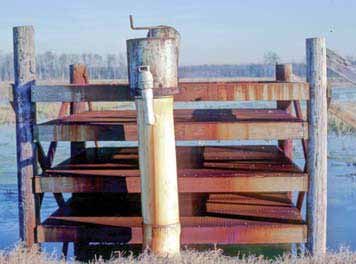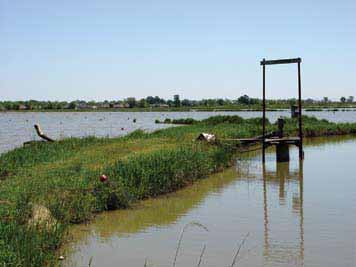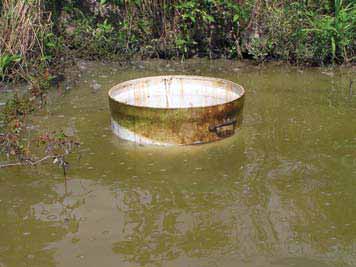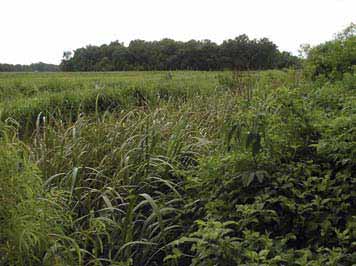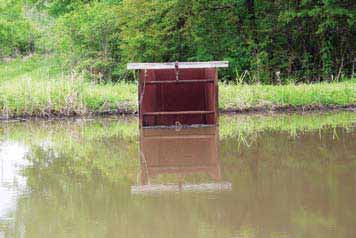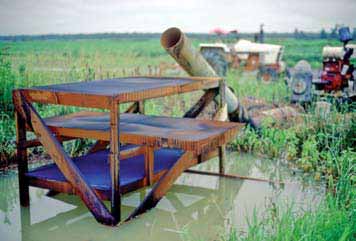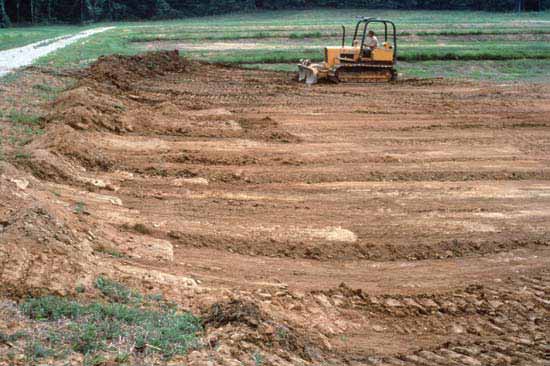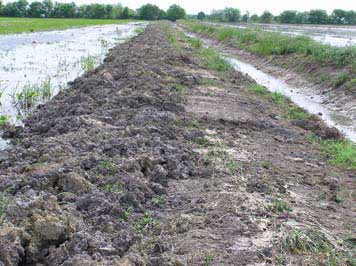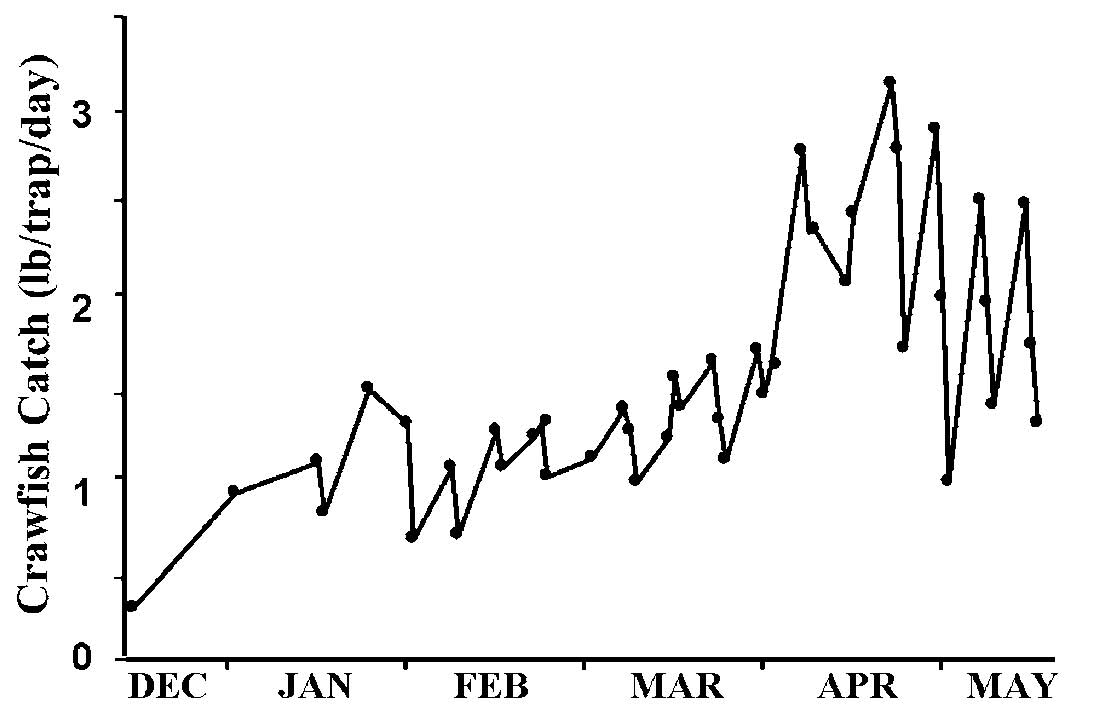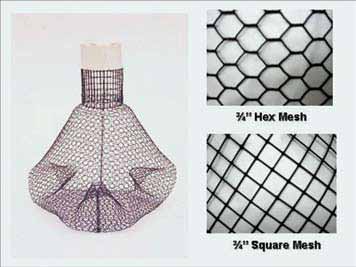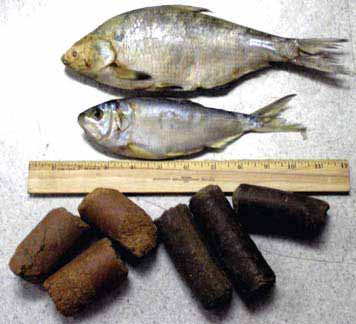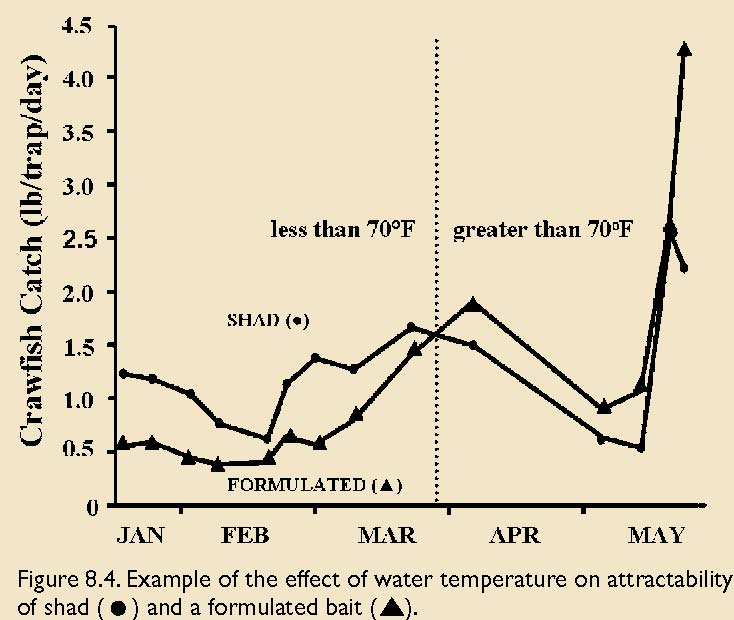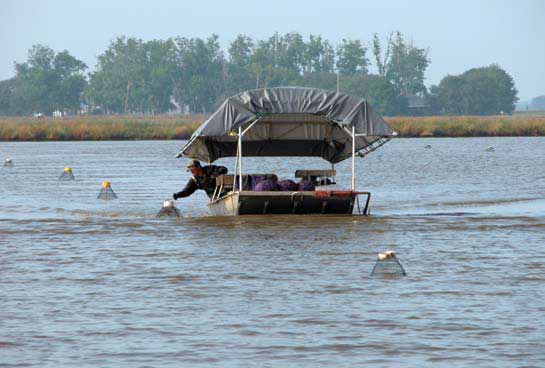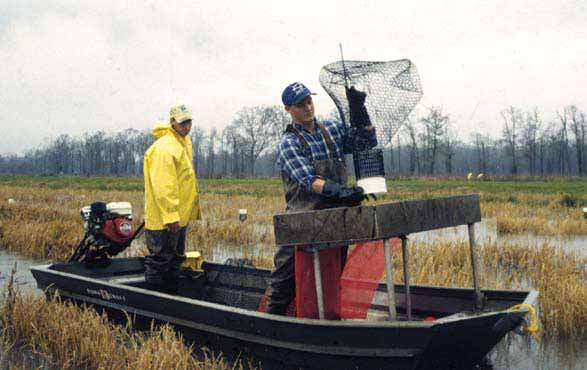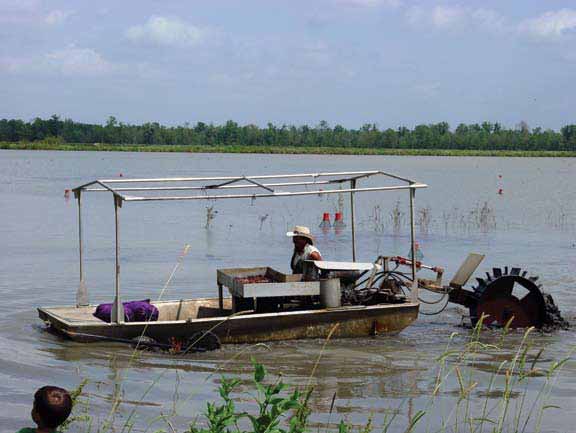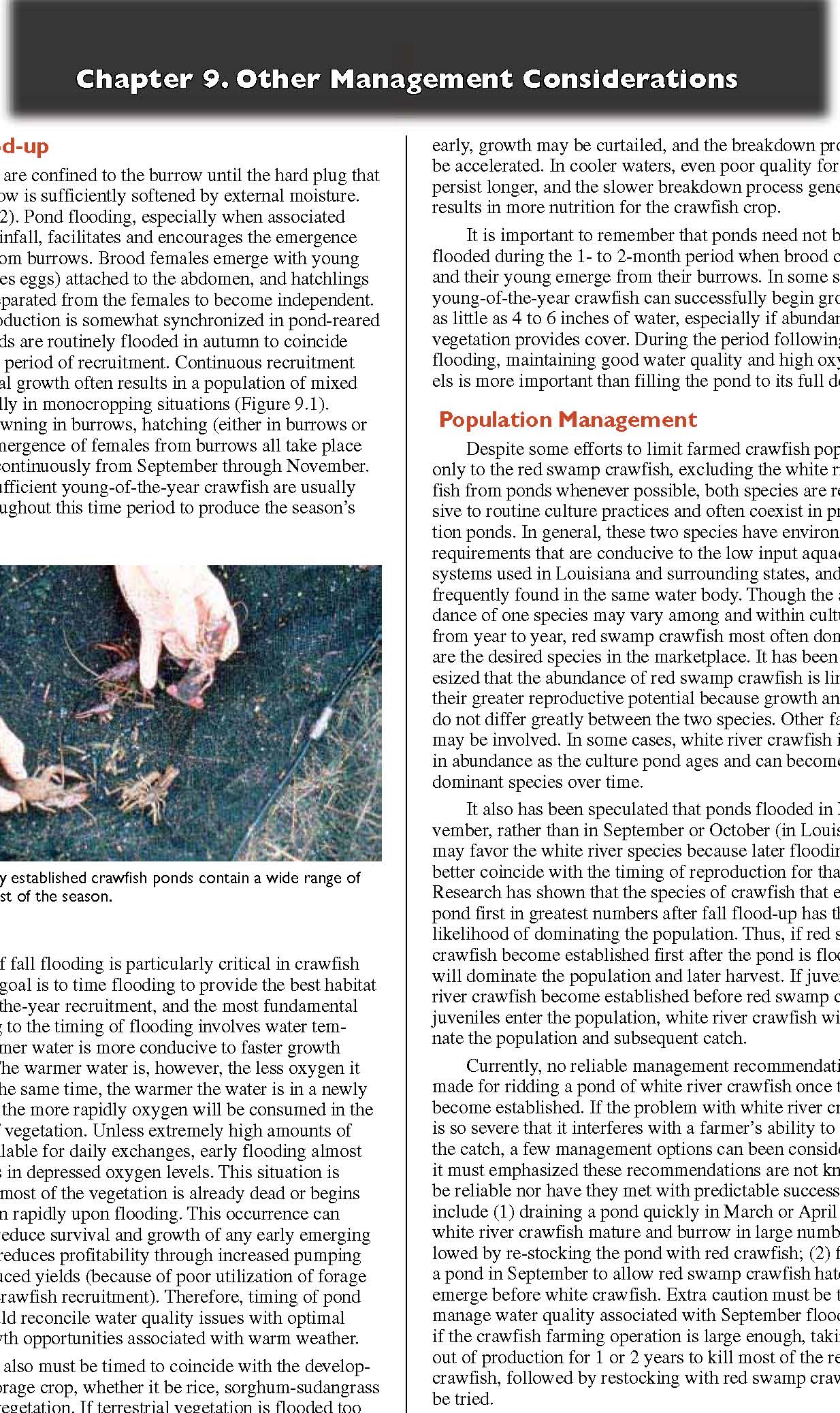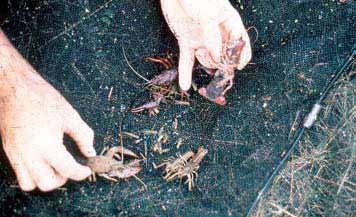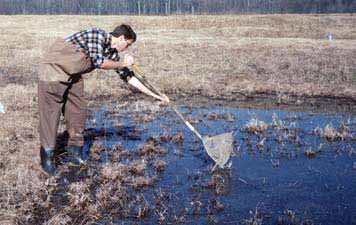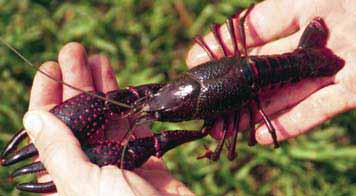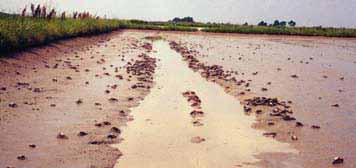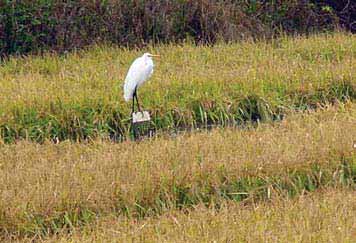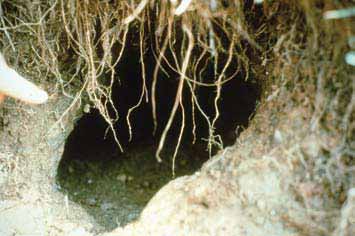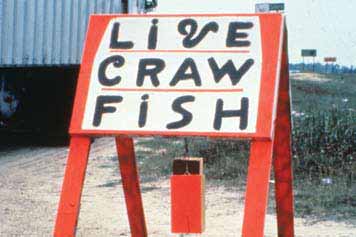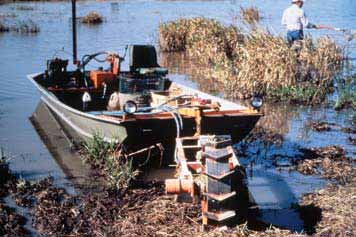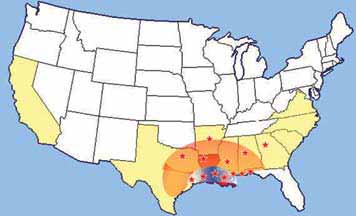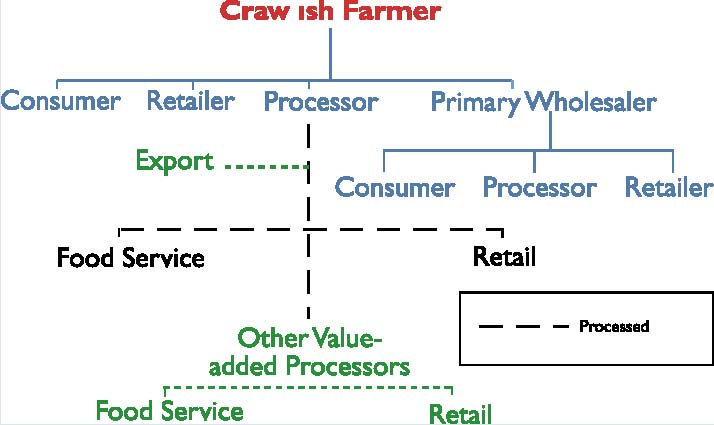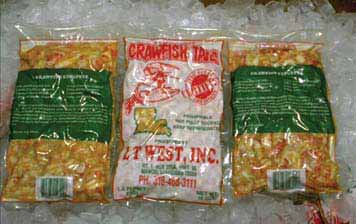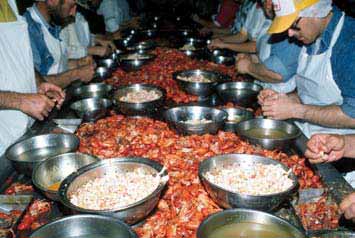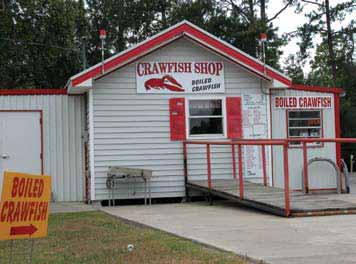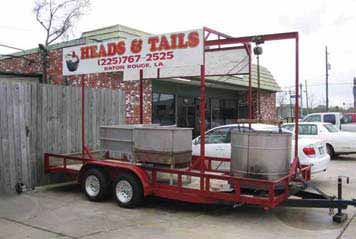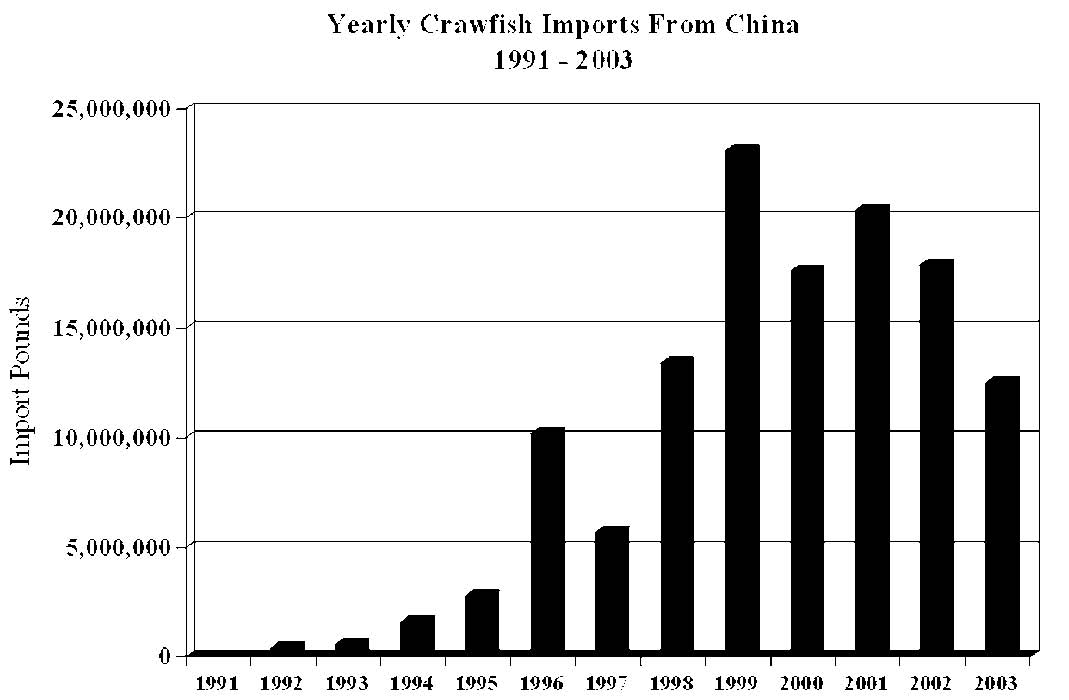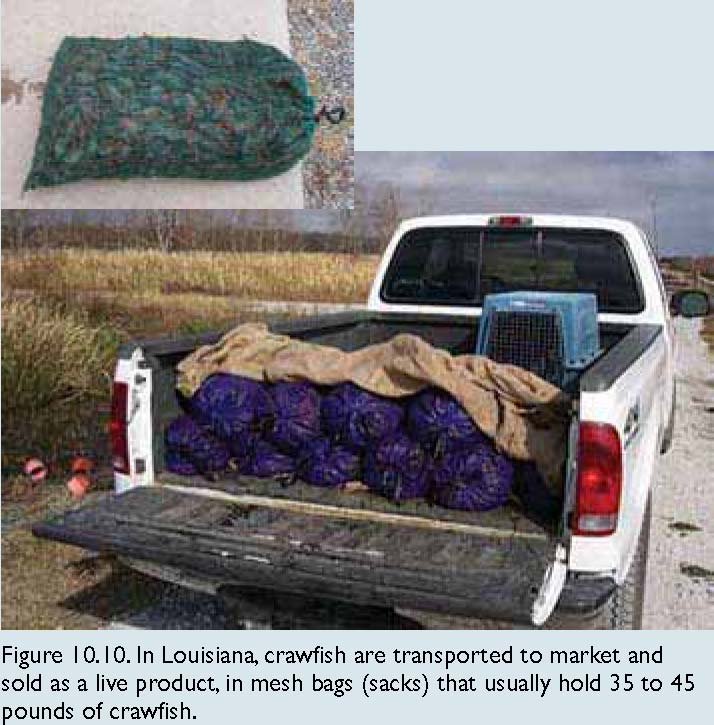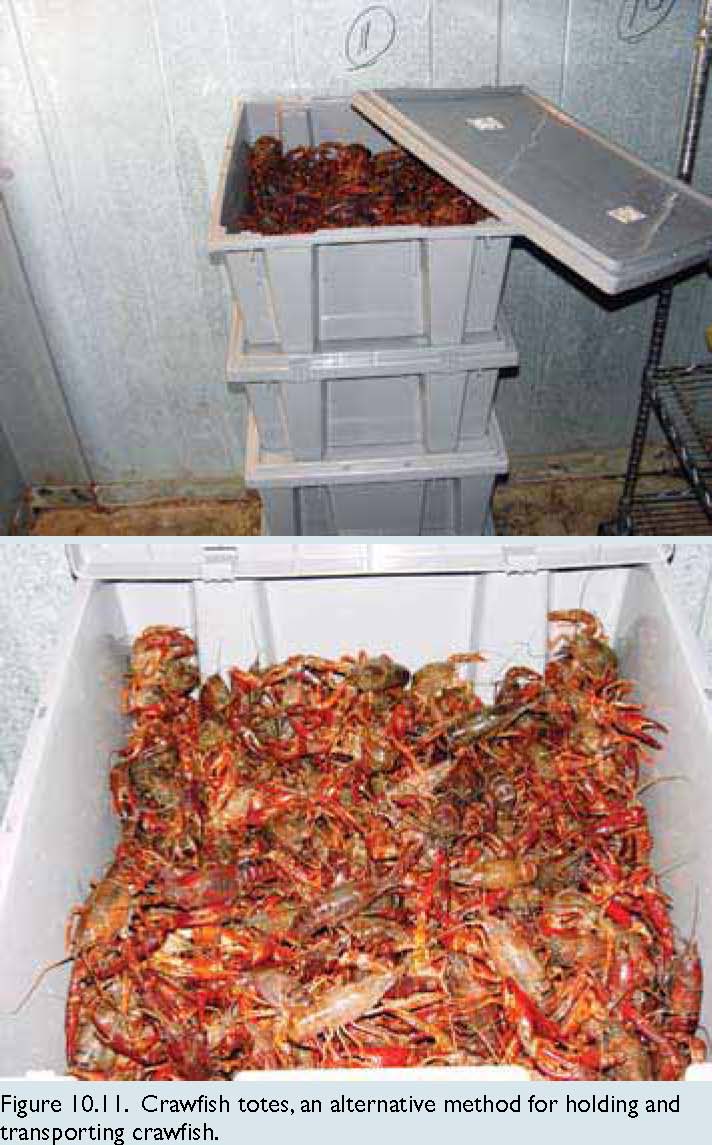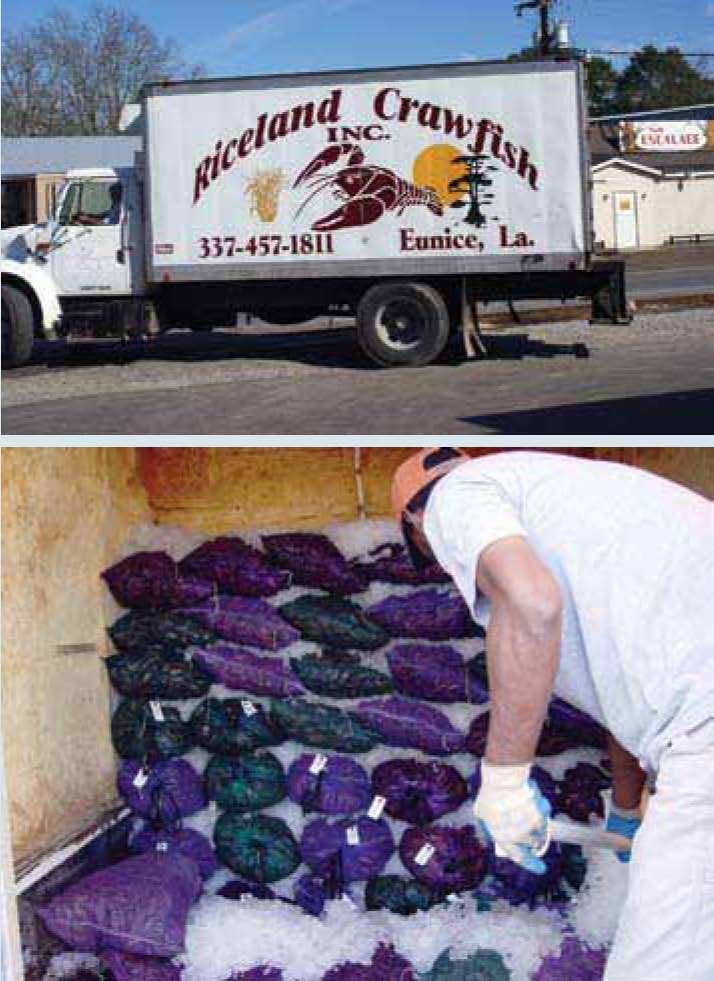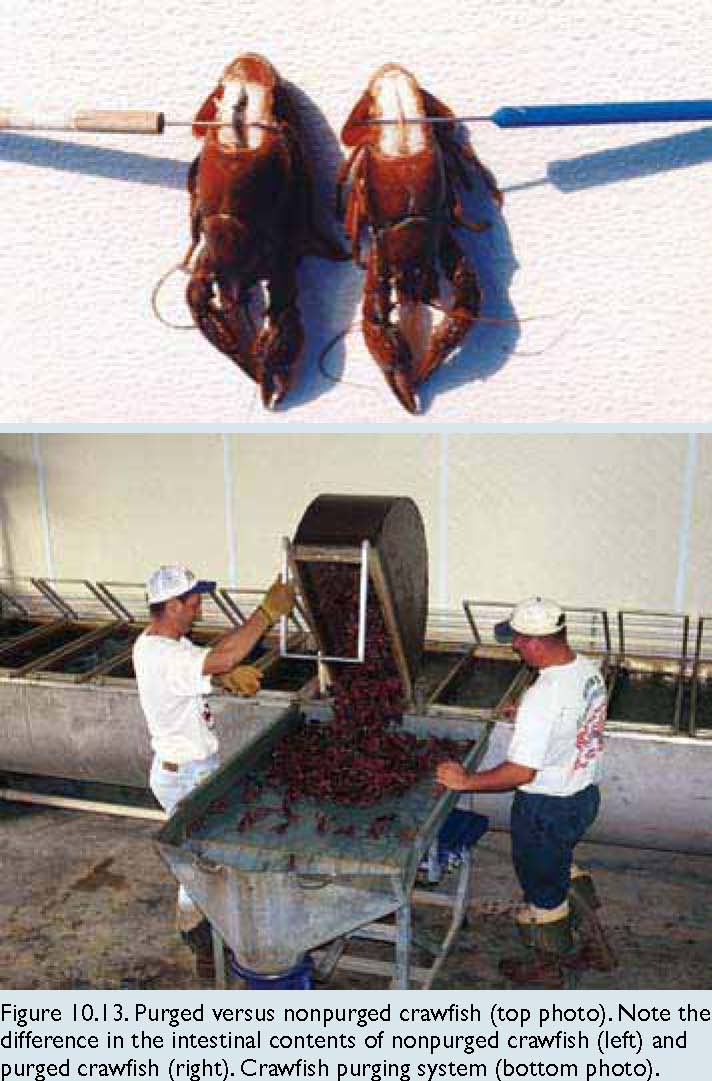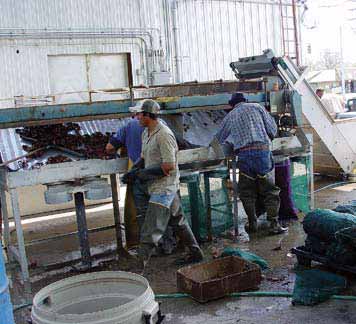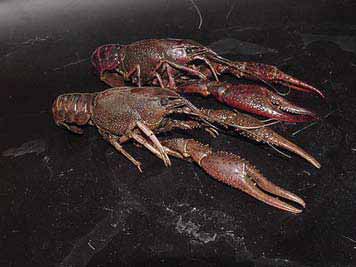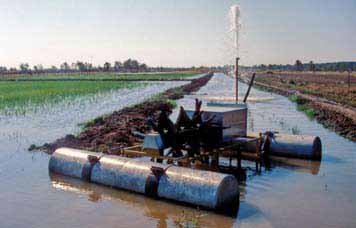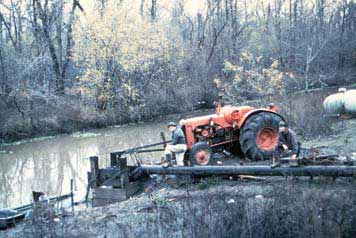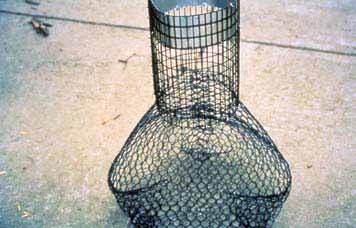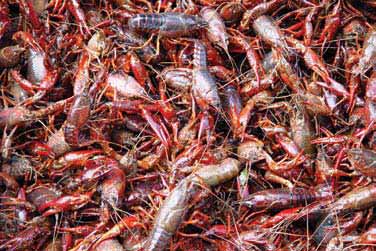
LOUISIANA CRAWFISH
PRODUCTION MANUAL

Table of Contents
NOTE: Mention or display of trade names or businesses in this publication does not constitute endorsement on the part of the LSU AgCenter, nor does it imply that other similar products or services are inferior or superior.
Chapter 1. Introduction
Whether from managed ponds or wild habitats, Louisiana's crawfish harvests are composed of two species – the red swamp crawfish (scientific name: Procambarus clarkii) and to a lesser extent the white river crawfish (scientific name: Procambarus zonangulus) (Figure 1.1). Although scientists in other parts of the world use the term “crayfish” for these and all related species, in this manual we refer to these two species as “crawfish” to reflect not just their common names, but also the widespread use of the word by producers, marketers and consumers in Louisiana and elsewhere in the United States.
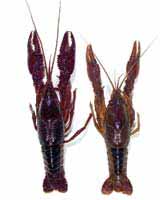
Louisiana's crawfish farming industry has grown to include more than 1,200 farms occupying more than 120,000 acres. Production from wild habitats, mainly the Atchafalaya River basin, varies from year to year. Total production for the 2004-2005 season was more than 82 million pounds, with almost 74 million pounds from farms and more than 8 million pounds harvested from natural habitats by approximately 1,100 fishermen. The farm-gate and dockside value of the 2004-2005 harvest exceeded $45 million.
Crawfish ponds have no standard size, but most are between 10 and 40 acres, and most producers manage 150 or fewer acres (Figure 1.2). Occasionally, a single pond may include more than 1,000 acres, especially in bottomland areas where water levels are manipulated in natural habitats for crawfish production (Figure 1.3).
Formulated feeds are not used to produce crawfish. Instead, rice, sorghum-sudangrass or natural vegetation is grown in the summer (when ponds are drained) to serve as the base of a natural food chain for crawfish. Crawfish ponds are not stocked with hatchery-reared young as in other forms of aquaculture. Farmers rely on reproduction by unharvested crawfish from the previous year or on mature crawfish that are stocked to produce young naturally.
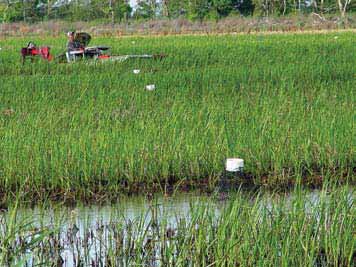
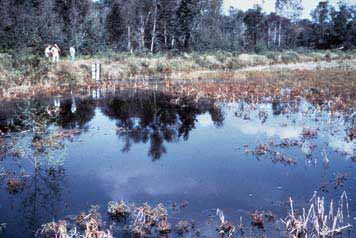
Educational and technical assistance in all aspects of crawfish production and marketing is provided by the LSU AgCenter through the Louisiana Cooperative Extension Service in every parish. Help is available through individual consultation, on-farm visits, production meetings and publications (Figure 1.4). Anyone considering going into crawfish farming should review current financial budgets available from the LSU AgCenter and discuss the feasibility of their projects or business plans with an extension professional who can identify the best available data for making decisions as to how to proceed. Louisiana Cooperative Extension Service agents and specialists are the best source of information on the feasibility of farming crawfish in your area.
History
Crawfish have been consumed for centuries by American Indians and in many parts of Europe. Commercial sales of crawfish in Louisiana began in the late 1800s. At that time, crawfish were harvested from natural waters throughout the southern region of the state. The first record of a commercial crawfish harvest in the United States was in 1880. That year, a harvest of 23,400 pounds was recorded, with a value of $2,140. By 1908, a U.S. Census report listed Louisiana's crawfish production at 88,000 pounds, with a value of $3,600.
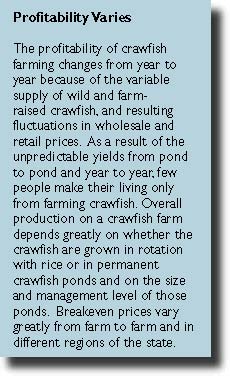
Example of image vs infobox webpage element.
Profitability Varies
The profitability of crawfish farming changes from year to year because of the variable supply of wild and farm- raised crawfish, and resulting fluctuations in wholesale and retail prices. As a result of the unpredictable yields from pond to pond and year to year, few people make their living only from farming crawfish. Overall production on a crawfish farm depends greatly on whether the crawfish are grown in rotation with rice or in permanent crawfish ponds and on the size and management level of those ponds. Breakeven prices vary greatly from farm to farm and in different regions of the state.
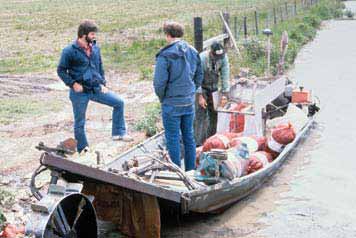
In the years following the Great Depression, crawfish sold for as little as 4 cents per pound. During this period, with the development of improved transportation and cold storage, crawfish markets within Louisiana shifted from local consumption in rural areas to higher-volume markets in cities such as Baton Rouge and New Orleans. During this same period, the introduction of wire mesh craw fish traps provided fishermen a much more efficient method of harvest (Figure 1.5).
In 1950, the Louisiana Legislature funded the Wildlife and Fisheries Commission to study the life history of crawfish in small ponds. By this time, the practice of re-flooding rice fields after grain harvest was occasionally practiced to produce crawfish for fam ily consumption. This practice of crawfish “farming” eventually spread to closed-in woodlands and marshland as well.
Up until this time, most of the crawfish available for people to consume had come from wild harvests in natural habitats. Although crawfish were abundant some years because of high water levels in the Atchafalaya Basin and other natural wetland areas, in other years crawfish were scarce and difficult to come by. This variation in supply made it difficult for markets to grow, but once crawfish farming began, more consistent supplies were possible.
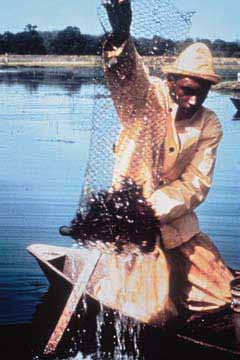
By the mid-1960s, the amount of land devoted to crawfish farming had increased to approximately 10,000 acres of managed ponds. At this point, an industry based on peeling crawfish became established, and the new markets for crawfish meat allowed both crawfish farming and wild harvests to increase even more (Figure 1.6). Acreage continued to increase in Louisiana, from approximately 44,000 acres in the mid-1970s to current levels of roughly 120,000 acres.
Small harvests of farmed crawfish for human consumption occur in other states, such as Texas, Arkansas, Mississippi, Alabama and the Carolinas, but Louisiana is by far the largest producer of crawfish in the United States. Official estimates are not available, but industry experts estimate that Louisiana usually accounts for 90 percent to 95 percent of the total U.S. production from year to year. The vast majority of crawfish aquaculture in the United States is focused on production for human consumption, but some pond-cultured crawfish are sold for fish bait or marketed as aquarium or scientific specimens.
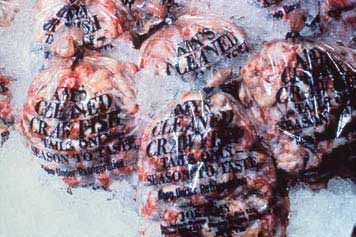
As the crawfish farming industry began to expand during the 1950s and early 1960s, a number of people felt that for economic growth and benefits to take place, harvests would have to become even more predictable from year to year. Predictability, however, would require research to develop recommended production practices. In 1964, researchers in Louisiana State University's School of Forestry and Wildlife Management began conducting research on crawfish biology and improved methods for pond production.
Initial research focused on how best to manage crawfish ponds to provide a productive habitat, including what type of vegetation to plant, when to plant it, when to flood the ponds, how many crawfish to stock, how to discourage natural predators such as insects and wild fish and other basic topics (Figure 1.7). As time went on and the industry continued to grow, research focused on solving more problems, such as improving trap designs, developing formulated baits that would not have to be refrigerated or frozen, managing the amount and quality of water used in producing crawfish, evaluating the possibility for genetic improvement of crawfish, looking at new ways to process crawfish, developing new products made with crawfish meat and many other topics.
A large portion of Louisiana's crawfish aquaculture, in excess of 50 percent, is practiced in conjunction with rice production. Crawfish farming fits well into many existing farm operations by using marginal agricultural lands, crop rotations, and permanent farm labor and equipment during off-peak farming periods. Crawfish can be produced either in permanent rotation with a rice crop year after year in the same location or in a field rotation with rice and occasionally some other crop, with restocking of crawfish each rotational cycle. As the economics of rice production in Louisiana have weakened over recent decades, many rice producers have turned to crawfish as an accessory crop that can be integrated into their existing farming operations.
How are Crawfish Classified?
Over the centuries, biologists have devised classification systems to represent groupings of animals and to better define where individual species fit within those groupings. With time, these systems have become more and more complicated, but this in turn provides more information about the relationships between species and groups of species.According to the most commonly accepted classification system, the red swamp crawfish and white river crawfish can be described as follows:
- Kingdom: Animalia (animals)
- Phylum: Arthropoda (crustaceans,insects, spiders, scorpions, etc.)
- Subphylum: Crustacea(crustaceans)
- Class: Malacostraca (crabs, pill bugs —rollie-pollies, krill, and related species and groups)
- Order: Decapoda (meaning ten legs: lobsters, shrimp, crabs, crayfishes— also called crawfishes, and relatives)
- Sub-Order: Pleocyemata
- Superfamily: Astacoidea (all crayfishes)
- Family: Cambaridae (cambarid crayfishes — one of three majorgroups of crayfish)
- Subfamily: Cambarinae (a group of NorthAmerican crayfish species, with more than 300 members)
- Genus: Procambarus
- Subgenus: Scapulicambarus (forred swamp crawfish), Ortmanicus (for white rivercrawfish)
- Species: clarkii (for red swamp crawfish), zonangulus (for white river crawfish, which was previously called acutus acutus for many years)
Scientists often refer to animals and plants by their genus and species classifications.Thus, the red swamp crawfish is referred to as Procambarus clarkii and the white river crawfish is Procambarus zonangulus.
Additional Sources of Information
Additional information on crawfish aquaculture and the crawfish industry, including news articles, crawfish statistics, fact sheets and newsletters that do not appear in this production manual can be found on the LSU AgCenter's Web site. Several fact sheets on crawfish farming and other very informative fact sheets on aquaculture in the southern United States can be found on the Southern Regional Aquaculture Center's Web site. To locate this Web site, type in “Southern Regional Aquaculture Center Fact Sheets” in the search command of your favorite Internet search engine. Personnel in your local LSU AgCenter extension office can assist you in obtaining the most current information available on crawfish farming or other aspects of agricultural production associated with crawfish farming.
Natural Fishery
Historically, significant harvests of wild crawfish have occurred in Louisiana.This production moves through the same market channels as farmed crawfish, affecting prices received by farmers. In recent years, however, many of the traditional areas of wild harvest have failed to produce large volumes of crawfish.To what extent this reduction in wild harvest might reflect long-term trends in water management, climate and habitat alteration remains uncertain. Since 2000, less than 20 percent of Louisiana's harvests on average have come from the wild fishery.
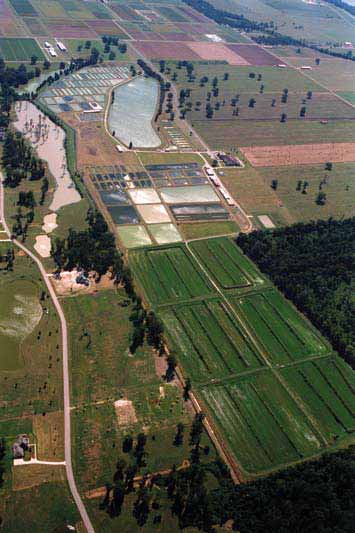
Chapter 2. Crawfish Biology
Procambarus clarkii (red swamp crawfish) and P. zonangulus (white river crawfish), the two species of commercial importance found in Louisiana crawfish ponds, have similar ecological requirements. As a result, it is not uncommon to find both species in the same pond. Both species are associated with natural cycles of flooding and drying common to much of Louisiana, and both construct burrows, in which they survive and reproduce during temporary dry periods. There are some differences between the two species, but care must be taken when reviewing information about the white river crawfish (see “How Are Crawfish Classified?” in chapter 1) because early references may refer to this species as P. acutus acutus, or P. zonangulus.
The red swamp crawfish produces more, but smaller, eggs than the white river crawfish, and it is capable of spawning year-round in the South. It appears to do better in more nutrient rich-waters than those of the white river crawfish. White river crawfish are seasonal spawners, usually spawning only in the autumn in the southern United States. Feeding rates have been found to be greater for the red swamp crawfish at temperatures in excess of 86 F, indicating a possible competitive advantage at higher temperatures. In contrast, the white river crawfish may grow faster at lower temperatures, and it typically reaches a slightly greater maximum size. Usually the red swamp crawfish are found in greater abundance in waters with lower dissolved oxygen (DO) content.
In general, both species are adapted to the conditions found in commercial crawfish ponds, and both respond well to the low input systems of production used in Louisiana. The abundance of one species or the other may vary among and within culture ponds over time, but the red swamp crawfish most often dominates and is the most desired species in the marketplace. White river crawfish are most often found in greatest numbers in ponds that are used to culture crawfish year after year.
How these two species interact in crawfish ponds is not fully understood, but one hypothesis is that the red swamp crawfish tends to dominate in more ponds because of greater reproductive potential and a more prolonged reproductive season. No major difference in growth rate and survival between the two species has been observed under typical culture conditions. Some researchers suggest that later pond flooding dates (late October to November) may favor the white river crawfish because of its tendency to spawn later and its slightly larger hatchlings. These factors would provide an advantage over red swamp crawfish young that hatched at the same time. Recent research suggests that whichever species successfully produces large numbers of babies first during autumn months will predominate in the pond for the rest of the season. Much information is lacking, however, regarding interactions of these two species.
These two species are often similar in appearance, especially at a young age. They can be easily identified, however, by experienced persons. Despite efforts to exclude white river crawfish from many farms, both species will thrive under routine culture practices, and they often coexist in production ponds. No evidence exists of natural hybrids between these two species. Several books provide an excellent overview of the anatomy and biology of these and other crawfish species.

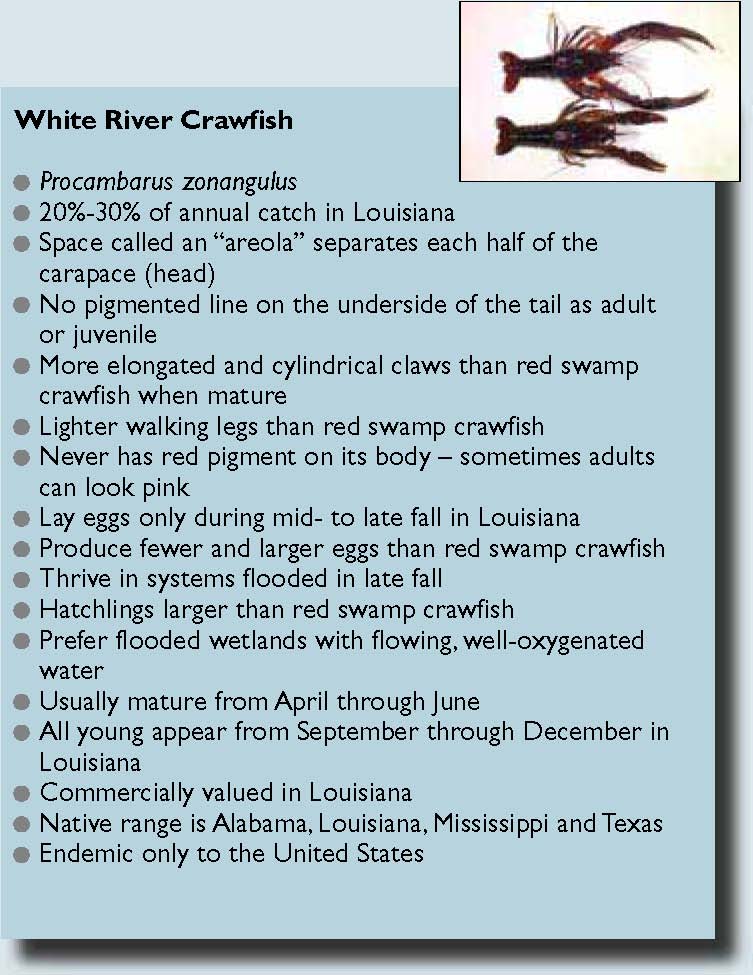
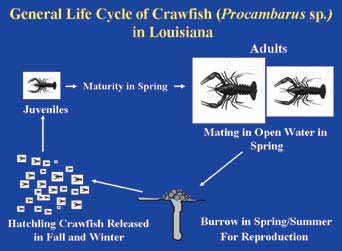
Life Cycles
Based on their distribution in North America, the red swamp and white river crawfish are classified as “temperate” species; that is, they will tolerate cold winter conditions. Both species, however, possess a number of traits that are usually associated with animals that live in warm waters. These species are short-lived (2 years or less), have high juvenile survival and can alternate between reproductively active and inactive forms. Moreover, P. clarkii is capable of spawning year-round in the southern United States, and some females can reproduce more than once per year.
These crawfishes have life cycles that are well-adapted to farm production strategies (Figure 2.1). Mature animals mate in open water where sperm is stored in a special receptacle, after which the female retreats to a burrow to eventually spawn. Burrowing activity can occur at any time but is most prevalent in late spring/early summer in Louisiana. Although spawning can take place in open water, the burrow provides protection while the fertilized eggs or young are attached to the underside of their mother's tail (Figure 2.2). Females carrying eggs or hatchlings are highly susceptible to predators, because they cannot use their normal tail-flipping escape response.
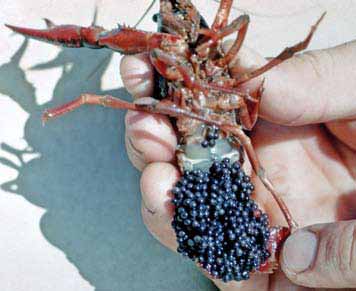
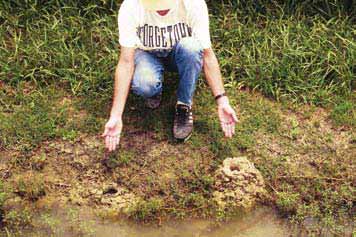
Crawfish of all ages and sizes, whether mature or immature and male or female, will dig or retreat to burrows to survive periods of dewatering. Crawfish ponds are usually drained during the summer months to allow for planting and growth of vegetation. Prior to draining, some mature crawfish burrow near the waterline (Figure 2.3). As the water level drops, additional crawfish burrows appear lower on the levee and are sometimes found on the pond bottom; however, the burrows on the pond floor often contain a high percentage of non-reproductive crawfish, such as males and immature juveniles.
Ovarian (egg) development in mature females is temperature dependent, usually beginning prior to burrowing and reaching completion within the burrow. Developing eggs within the ovary become rounded, increase in size, and change from a light color to dark as they mature (Figure 2.4). At maturity, the large black eggs are shed from between the walking legs, are fertilized externally and are then attached to the swimmerets on the underside of the tail with an adhesive substance called glair. Although crawfish can survive in high humidity within the burrow, some standing water is necessary for successful reproduction. The number of eggs laid varies with female size and condition, but large red swamp or white river crawfish females can have more than 500 eggs.
The hatching period depends on temperature and usually takes about 3 weeks. Hatched crawfish are attached to the female's swimmerets through two molting phases, after which they resemble an adult crawfish and begin to feed. Hatchlings instinctively remain with the female for several weeks after their second molt although they are no longer attached. It is critical that the female and her young leave the burrow within a reasonable time because little food is available in burrows. When conditions force the crawfish to remain in the burrow, increased mortality can occur.
Pond flooding or heavy rainfall is usually necessary to encourage female crawfish to emerge from their burrows. Females emerge with their young (or sometimes with eggs) attached to their tails (Figure 2.5), and advanced hatchlings are quickly separated from their mother as she moves about in the open water. Because reproduction is somewhat synchronized in pond-reared crawfish, ponds are routinely flooded in autumn to coincide with the main period of reproduction. White river crawfish are autumn and winter spawners, but red swamp crawfish reproduction may occur at any time. Peak reproduction of red swamp crawfish, however, usually occurs in autumn, with minor pulses (or “waves”) of hatchlings entering the population later. Extended reproduction and differential growth typically result in a population of mixed sizes in most ponds.
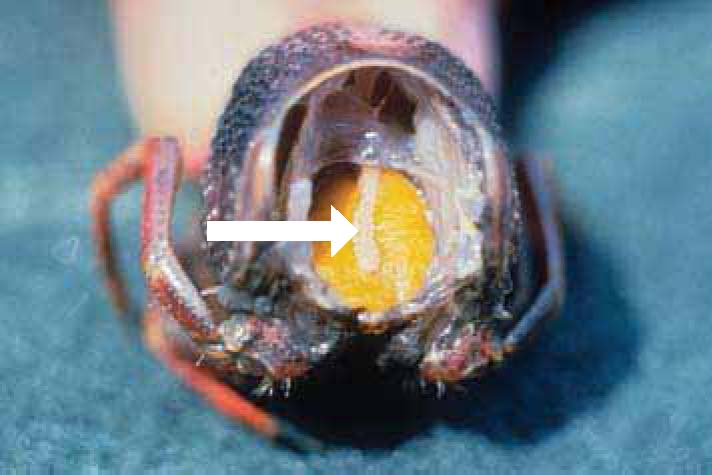
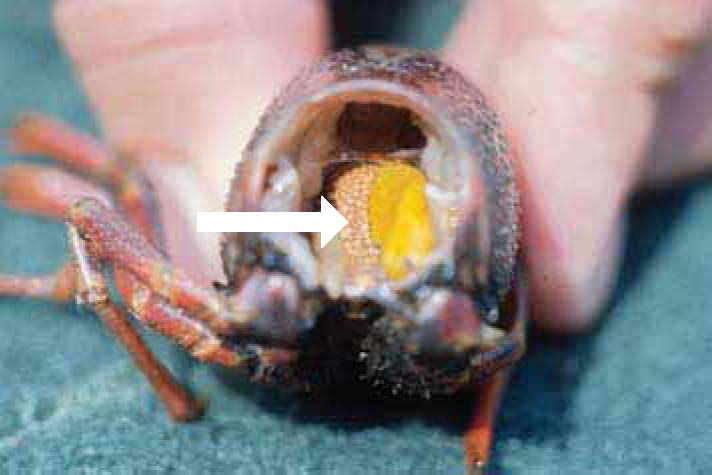
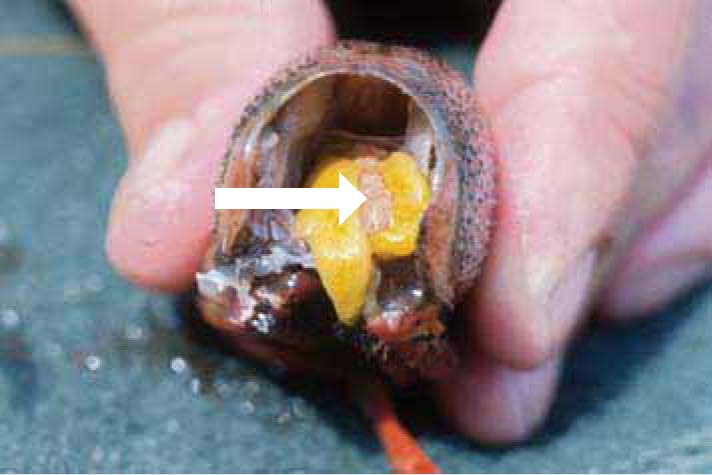

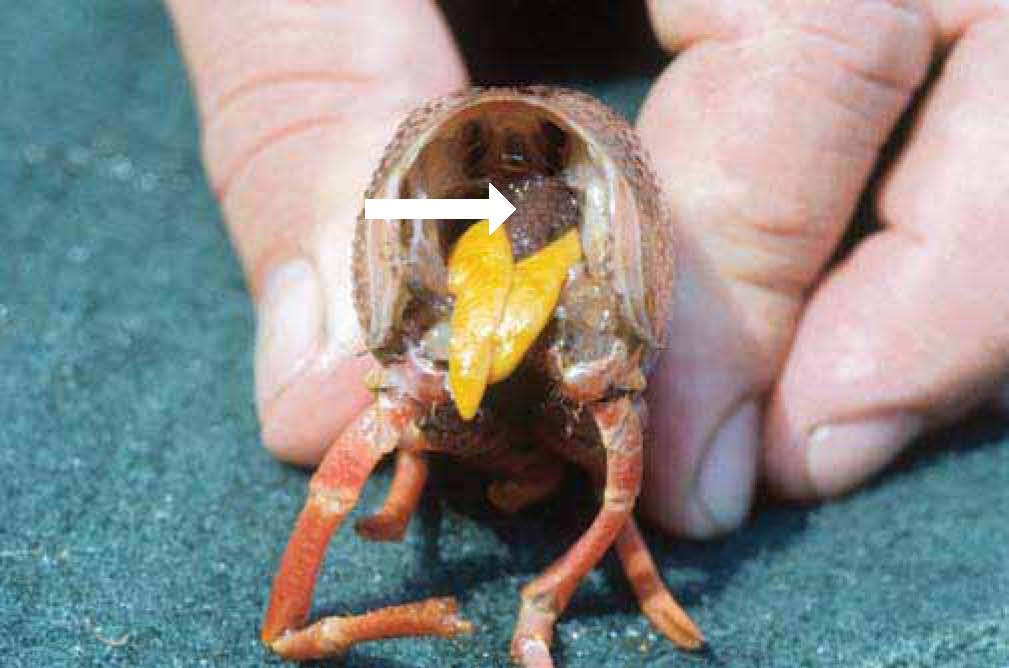
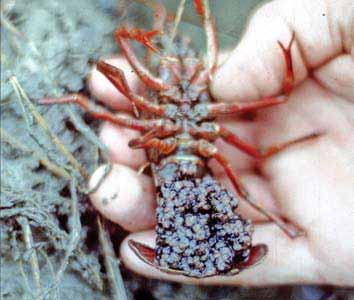
As with all crustaceans, a crawfish must molt or shed its hard exoskeleton to increase in size. Frequent molting and rapid growth occur in production ponds when conditions are suitable. Growth rate is affected by a number of variables, including water temperature, population density, oxygen levels, food quality and quantity, and to a lesser extent by genetic influences. Harvest size is typically reached 3 to 5 months after hatching for fall recruits, but it can be attained in as little as 7 to 9 weeks under optimum conditions.
When males and females molt to a reproductively active stage, growth ceases. Sexually mature individuals exhibit distinct characteristics, including darker coloration, enlarged claws, and hardened sexual structures. Mature males also develop prominent hooks at the base of the third and fourth pair of walking legs. The appearance of mature crawfish in the population usually increases as temperatures rise during late spring. Females will mate (often several times) after molting to a mature form and then begin the process of constructing burrows at the water's edge on levees.
Burrow Ecology
Several studies have provided more detail of crawfish burrows, but, in brief, crawfish cultured in Louisiana dig simple (unbranched), nearly vertical burrows, usually 40 inches or less in depth (Figure 2.6). Burrows serve as refuges from predators and provide moist or humid environments necessary for crawfish to survive through dry periods. Louisiana crawfish have evolved over millions of years to reproduce within the protection of their burrows. Most burrows are built at night and may require several days to complete. Crawfish burrows are usually dug by a single individual, and the burrow diameter is determined by the size of the crawfish. The burrow extends downward into a chamber slightly larger than the diameter of the tunnel.
Water levels in burrows vary with the moisture conditions in the soil. Free water at the bottom of the burrow is more often associated with “trapped” water than the actual water table of the soil. Walls of the burrow and terminal chambers are extensively worked by the crawfish, possibly to ensure good seals. The terminal chamber normally contains wet slush when water is not present, which serves as a humidifier. The entrance of the completed burrow is eventually closed with a mud plug (Figure 2.7), sometimes having a chimney or stack of the soil removed during excavation. Burrow entrances at the water's edge are often associated with natural cover, such as vegetation or woody debris. Over the course of the summer, weathering and covering by vegetation may make the burrow entrance undetectable.
Burrows usually contain a single female, or sometimes a male and female together, but occasionally they may contain additional crawfish. Successful survival and reproduction within the burrow depends on many factors, such as the severity and length of the dry period, characteristics of the burrow (such as depth, soil type and moisture) and health of the animal. Immature crawfish and crawfish forced to burrow by rapidly dropping water levels may construct shallow burrows that will not have sufficient moisture for survival during lengthy dry periods or drought. Soil types with limited clay content or soil with very high clay content that cracks when dry also may limit crawfish survival while in burrows.
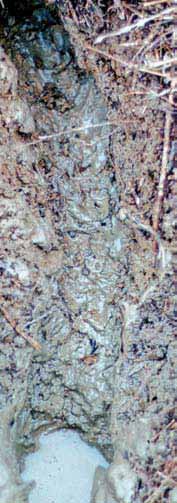
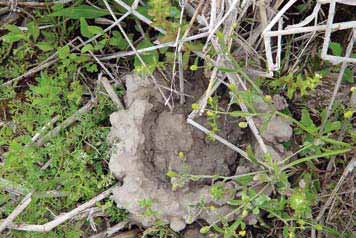
Once sealed in, crawfish are confined to the burrow until the hard plug that seals the entrance is sufficiently softened by external moisture from flooding or rainfall. Pond flooding, especially when associated with heavy rainfall, facilitates and encourages the emergence of crawfish from burrows.
Crawfish Population Structure
The appearance of new hatchlings in a pond is referred to as “recruitment,” and these crawfish usually constitute the bulk of the annual harvest, even when significant numbers of holdover juvenile crawfish are present after flooding. Pond crawfish populations usually include (1) holdover adults from the preceding production season or stocking, (2) holdover juveniles from the preceding season and (3) the current young-of-the-year (YOY) recruits.
The number of age classes and numbers within age classes comprise the overall crawfish density. Crawfish density and population structure have a great impact on overall pond yields and size of crawfish at harvest.The highest densities and most complex population structures usually occur where crawfish have been grown in the same location for several consecutive seasons. In new ponds and ponds held out of production for a year or longer, crawfish density is often lower and the number of age classes is fewer. In these situations, crawfish are often larger and more uniform in size; however, overall yields may be considerably lower.
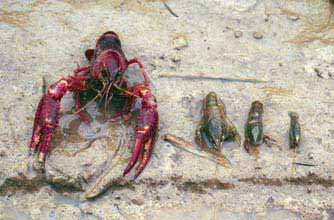
Population Dynamics
Unlike most aquaculture ventures, where known numbers and sizes of juveniles are stocked, crawfish aquaculture in Louisiana relies on natural recruitment (reproduction) from mature animals (either stocked or already present) to populate the pond. Population density depends largely on broodstock survival, successful reproduction and survival of offspring. Density is mainly influenced by environmental conditions over which producers may have little or no control. Additionally, improper management after autumn flood-up, including low oxygen levels, abundance of predators or pesticide exposure can negatively impact crawfish populations and subsequent production even when broodstock survival and reproduction are high.
Because of this lack of influence and control over population levels, population density and structure is probably the most elusive aspect of crawfish production. Extended reproduction periods and the presence of carryover crawfish from previous season often result in several size or age groups of crawfish being present in a pond at any given time. These various size/age groups are what make up the population structure.
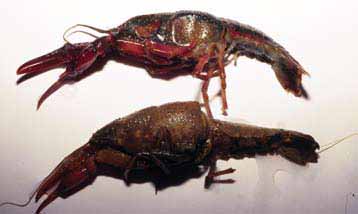
Although “natural recruitment” in crawfish farming has many advantages, a significant disadvantage is that crawfish producers have little means of accurately controlling or even determining population density and subsequent yield. Available sampling methods are crude and currently include dip net sweeps and use of “test” traps. These methods are highly variable and subject to many sources of bias or error. Producers generally do not have a good assessment of their populations until harvesting is well underway in late spring, after pond temperatures have increased substantially.
Molting
As with all crustaceans, a crawfish must molt or shed its hard external shell (“exoskeleton”) to increase in size (Figure 2.8); hence, the growth process involves periodic molting interspersed with inter-molt periods. Approximately 11 molts are necessary for young crawfish to reach maturity. A molt cycle is recognized as having five major stages, but it should be understood that the process is actually continuous. The inter-molt phase is the period in which the exoskeleton is fully formed and hardened. During this phase, crawfish feed actively and increase their tissue and energy reserves. Preparation for molting takes place in the pre-molt stage. This includes the formation of the new, underlying (soft) exoskeleton while a re-absorption of the calcium from the old shell occurs. During the late pre-molt period, crawfish cease feeding and seek shelter or cover.
Molting is usually accomplished in minutes. The brittle exoskeleton splits between the carapace (head) and abdomen (tail) on the back side, and the crawfish usually withdraws by tail flipping. During the “soft” phase that follows, the soft exoskeleton expands to its new, larger dimensions. Hardening (calcification) of the new exoskeleton takes place during the post-molt period, which can be divided into two phases. Initial hardening occurs when calcium stores within the body are transported to the new exoskeleton. Calcium is stored in the body both in soft tissue and for a short period in two hard “stomach stones” or gastroliths (Figure 2.9) located in the head, on each side of the stomach. These stones disappear during the initial hardening period after molting. The second phase of hardening is by absorption of calcium from the water. As crawfish resume feeding, further hardening of the new shell occurs.
Molting is hormonally controlled, occurring more frequently in younger, actively growing animals than in older ones. The increase in crawfish size during molting, and the length of time between molts, can vary greatly and are affected by factors such as water temperature, water quality, food quality and quantity, population density, oxygen levels and to a lesser extent by genetic influences. Under optimum conditions, crawfish can increase up to 15 percent in length and 40 percent in weight in a single molt.
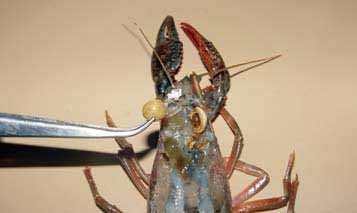
In culture ponds, frequent molting and rapid growth occur during spring because of warming waters and adequate food sources. The appearance of mature crawfish increases as the season progresses. Rapid increases in temperature (above 80 F) may stimulate onset of maturity at smaller sizes, especially under conditions of overcrowding and food shortages. “Stunting,” the condition whereby crawfish mature at an undesirably small size, is a problem in many ponds.
Nutrition
Crawfish have been classified as herbivores (vegetation eaters), detritivores (consumers of decomposing organic matter), omnivores (consumers of both plant and animal matter) and, more recently, obligate carnivores, which means that they “require” some animal matter in the diet for optimal growth and health.
Crawfish have been known to ingest living and decomposing plant matter, seeds, algae, epiphytic organisms, microorganisms and an assortment of larger invertebrates such as insects and snails. They also will feed on small fish when possible. These food sources vary considerably in the quantity and quality in which they are found in the aquatic habitat. Living plants, often the most abundant food resource in crawfish ponds and natural habitats, are thought to contribute little to the direct nourishment of crawfish. Starchy seeds are sometimes consumed and may provide needed energy, but intact fibrous plant matter is mostly consumed when other food sources are in short supply. Aside from furnishing a few essential nutrients, living plant matter provides limited energy and nutrition to growing crawfish.
Decomposing plant material, with its associated microorganisms (collectively referred to as detritus) is consumed to a much greater degree and has a higher food value. The ability of crawfish to use detritus as a mainstay food item, however, appears to be very limited. Fortunately, in a typical crawfish pond environment numerous animals besides crawfish rely on the microbe-rich detritus as their main food source. Mollusks, insects, worms, small crustaceans and some small vertebrates depend on detritus (Figure 2.10) and, when consumed by crawfish, these animals furnish high-quality nutrition. Scientists have realized that for crawfish to grow at their maximum rate, they must feed to a greater extent on these high-protein, energy-rich food sources.
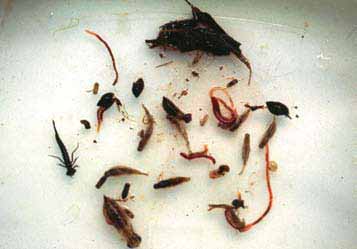
Sufficient evidence has been established to indicate that although crawfish must consume high-protein, high-energy sources to achieve optimum growth, they can sustain themselves for some time by eating intact and decomposing plant sources and even bottom sediments containing organic debris.
Supplemental feeds are not routinely provided to crawfish aquaculture ponds. Commercial culture of crawfish relies on a self-sustaining system for providing nourishment to crawfish, as occurs in natural habitats where crawfish are abundant. An established (or at least encouraged) vegetative forage crop provides the basis of a complex food web (Figure 2.11) that ultimately fuels production of crawfish with harvests that typically average 400-600 pounds per acre and can often exceed 1,000 pounds per acre.
Plant fragments from the decomposing vegetation provide the “fuel” that drives a detrital-based production system, with crawfish at the top of the food web. As a result, the main means of providing nutrition to crawfish in aquaculture is through establishing and managing a forage crop. Ideally, once ponds are flooded in the fall, a constant and continuous supply of plant fragments fuels the food web from which crawfish derive their nutrition. (Also see chapter 5.)
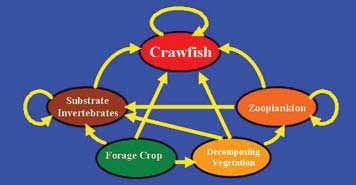
Chapter 3. Crawfish Production Systems
Commercial culture of Louisiana crawfish relies on earthen ponds, with production methods that are much less intensive than those found in other forms of aquaculture. The methods used for crawfish aquaculture is little more than limited control of the environmental conditions under which these animals evolved.
Red swamp and white river crawfish are naturally adapted to habitats with seasonal flooding and drying, where the dry period usually occurs from summer into autumn. The life cycle of crawfish is well suited to fluctuating periods of flooding and dewatering. In their natural, river or swamp habitats, sustained periods of river overflow permit crawfish to feed, grow and mature. Temporary dewatering, in both natural habitats and crawfish ponds, promotes aeration of bottom sediments, reduces abundance of aquatic predators and allows for establishment of vegetation that serves as cover for crawfish and the source of important food resources when water returns. Crawfish survive the dry intervals by digging or retreating to burrows where they can avoid predators, acquire moisture necessary for survival and reproduce in safety.
Current farming practices are based on the annual water cycles and conditions to which these crawfish have become adapted over millions of years. Flooding and draining of crawfish ponds mimic the natural flooding and drying cycle in Louisiana's Atchafalaya River basin. The control achieved under farming conditions provides optimal timing of these events and allows crawfish producers to positively influence water quality, food resources and other factors within their ponds. As with natural ecosystems, crawfish aquaculture relies on natural reproduction. No hatcheries or nurseries are required. Crawfish in forage-based culture ponds, as in the wild, depend on a naturally available food web for nourishment. Supplemental feeding is not a common practice; it has not yet been shown to predictably increase yields or size of crawfish at harvest.
Crawfish are grown in shallow earthen ponds 8 to 24 inches deep. Relatively flat, easily drained land, with suitable levees, is required for production, harvesting and management of vegetation (Figure 3.1). Crawfish are cultured in areas where the soil has sufficient clay to hold water and accommodate bur-row construction. Water requirements for crawfish production are similar to those for other freshwater aquaculture ventures, with the possible exception of water quantity. Ponds are flooded in the fall and drained in the spring, and because of the oxygen demand from decaying vegetation, additional water exchanges are sometimes necessary.
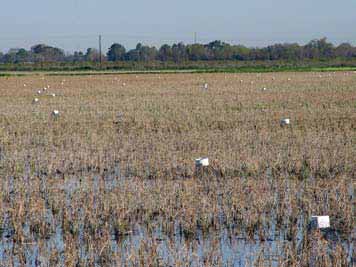
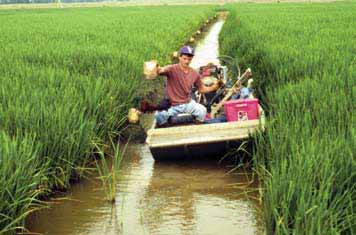
Equipment requirements for culturing crawfish include irrigation systems, harvesting equipment (boats, traps, sacking tables, etc.) and agricultural implements to establish the forage crop and maintain levees (Figure 3.2). Access to sufficient labor and alternative marketing outlets are essential for successful commercial operations.
Although crawfish aquaculture ponds are sometimes categorized by pond type or dominant vegetation, a better strategy is perhaps to categorize ponds by two basic production strategies. (See summary of production strategies in Table 3.1) One strategy is monocropping, or monoculture, in which crawfish are the sole crop harvested, and production typically occurs in the same physical location for several production cycles or even longer.
A second strategy is the crop rotation system, in which rice, and sometimes soybeans or other crops, are raised in rotation with the crawfish. In these systems, crawfish are either rotated with rice in the same physical location year after year, or crawfish are cultured in different locations each year to conform to normal field rotations of the other crops.
Although these two major management strategies have many similarities, different production goals dictate different management concerns.
Monocropping Systems
Crawfish monoculture or “single-crop” systems is the production method of choice for many small farms or where marginal lands are available and unsuited for other crops. Permanent ponds, or sites devoted to at least several consecutive production cycles, are typically used for this strategy. Pond size and production input for this approach range from large (greater than 300 acres) impounded wetlands with little management to small (less than 15 acres) intensively managed systems. The main advantage of a monocropping strategy is that producers can manage for maximum crawfish production without the various concerns associated with other crops, such as pesticide exposure, seasonal limitations and other constraints associated with crop rotation.
| Table 3.1. Summary of Major Crawfish Production Strategies With Common Practices by Month. | ||||
|---|---|---|---|---|
| Months | Crawfish Monoculture | Crop Rotational Systems | ||
| Rice-Crawfish- | Rice | Rice-Crawfish-Fallow or (Rice-Crawfish-Soybean) | ||
| Jul - Aug Sep - Oct Nov - Dec Jan - Feb Mar - Apr May - Jun July - . . . | Forage crop planted or natural vegetation allowed to grow Pond flooded and water quality monitored and managed Harvest when catch can be economically justified Crawfish harvested 2-4 days per week according to catch and markets Crawfish harvested 3-5 days per week according to catch and markets Crawfish harvested until catch is no longer justified; then pond drained Repeat cycle | Rice crop harvmanaged foPond flooded iquality monitorHarvest when justified Crawfish harveaccording to caCrawfish harveuntil late April, and readied forRice planted inmanaged for grRepeat cycle r re | ested in August and stubble n October and water ed and managed catch can be economically sted 2-4 days per week tch and markets sted 3-5 days per week then pond drained planting May and rice crop ain production growth | Rice crop harvested and stubble managed for regrowth Pond flooded in October and water quality monitored and managed Water quality monitored and managed Crawfish harvested 2-4 days per week according to catch and markets Crawfish harvested 3-5 days per week according to catch and markets Pond drained and soybeans planted or harvest proceeds as long as catch is feasible; pond then drained and left fallow Harvest soybeans in October, plant rice in March/April, stock crawfish in May, repeat cycle |
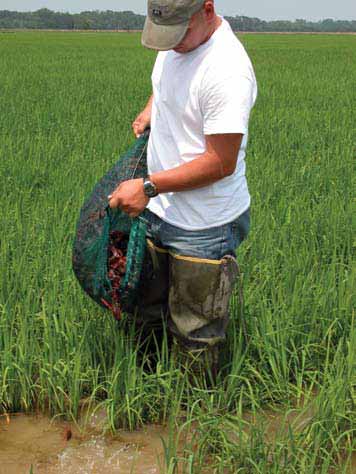

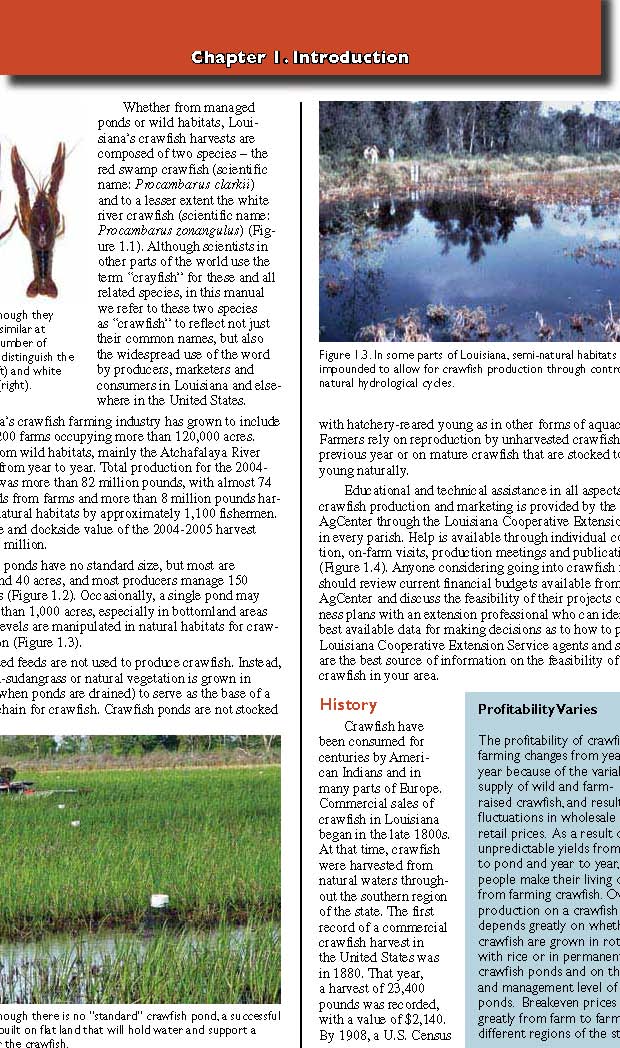


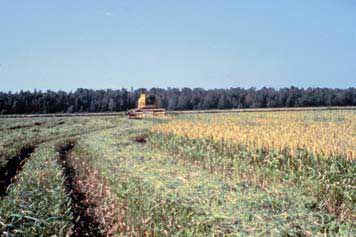

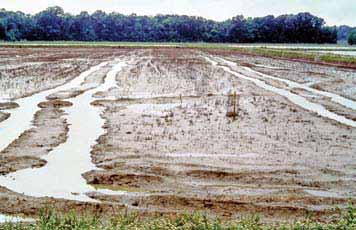
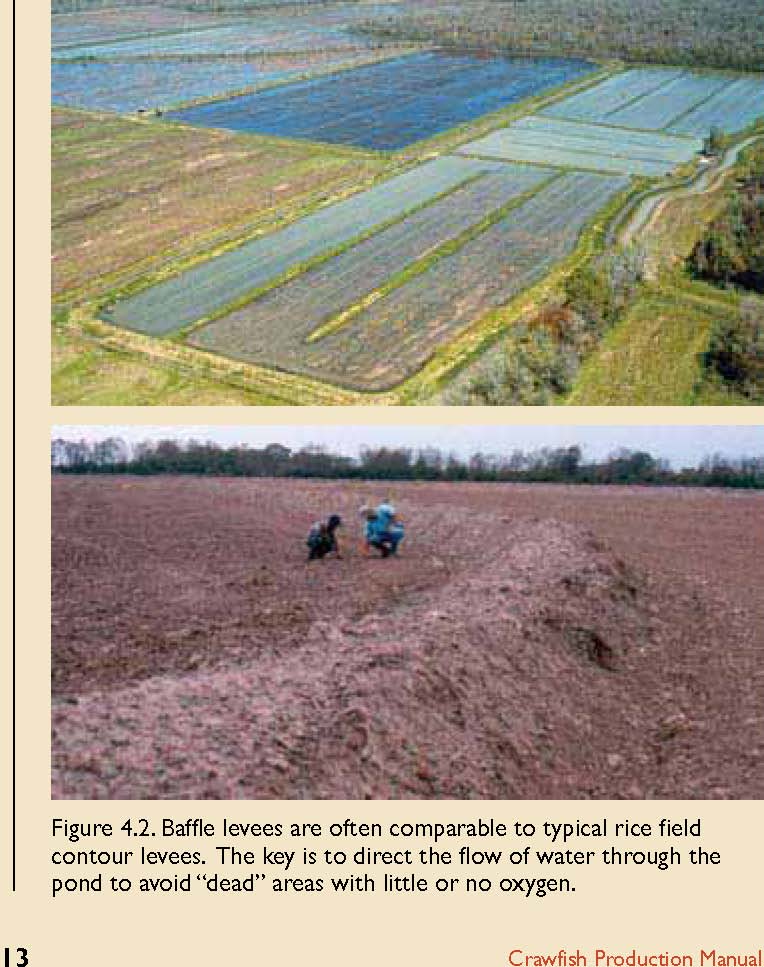
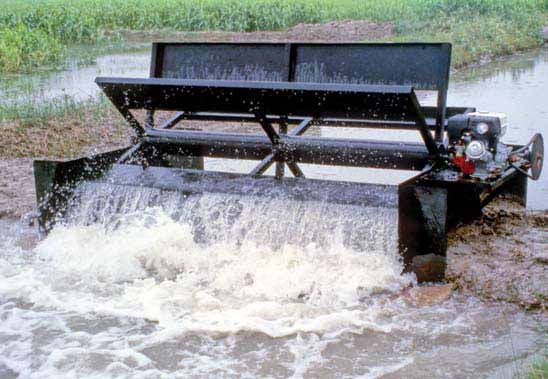 Figure 4.4. When ponds are extremely level, recirculation can be accomplished using commercially available
or shop-built paddlewheel aerators.
Figure 4.4. When ponds are extremely level, recirculation can be accomplished using commercially available
or shop-built paddlewheel aerators.
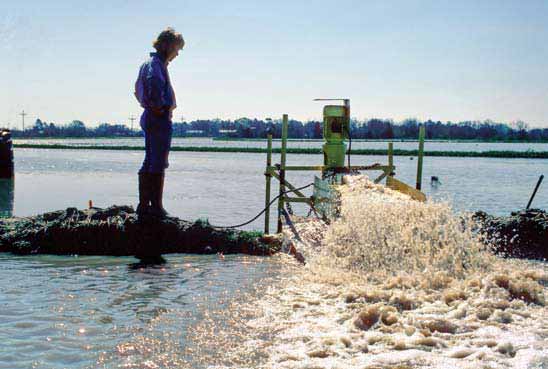
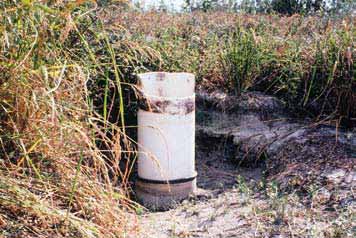

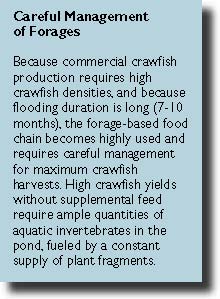 A continual supply of vegetative matter for decomposition is
necessary throughout the production season to feed the
invertebrate population. This requires a forage crop that yields
small portions of its material on a consistent basis over the
duration of the season. Too much vegetative input into the system
at one time is wasted because it cannot be stockpiled; thus, a
large portion deteriorates without being consumed. Also, excess
contribution at one time leads to premature depletion of the food
resource and can cause low oxygen conditions. Too little
vegetative detritus can result in actual food shortages for the
organisms that crawfish rely on as high quality food items and,
therefore, food shortages for crawfish.
A continual supply of vegetative matter for decomposition is
necessary throughout the production season to feed the
invertebrate population. This requires a forage crop that yields
small portions of its material on a consistent basis over the
duration of the season. Too much vegetative input into the system
at one time is wasted because it cannot be stockpiled; thus, a
large portion deteriorates without being consumed. Also, excess
contribution at one time leads to premature depletion of the food
resource and can cause low oxygen conditions. Too little
vegetative detritus can result in actual food shortages for the
organisms that crawfish rely on as high quality food items and,
therefore, food shortages for crawfish.
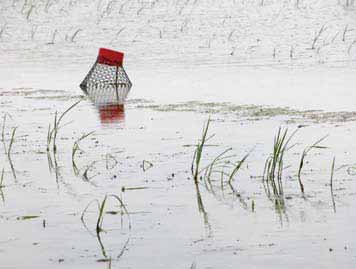
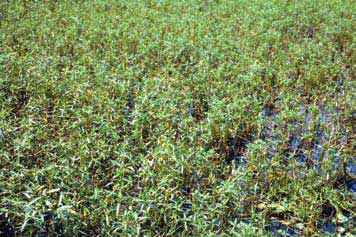
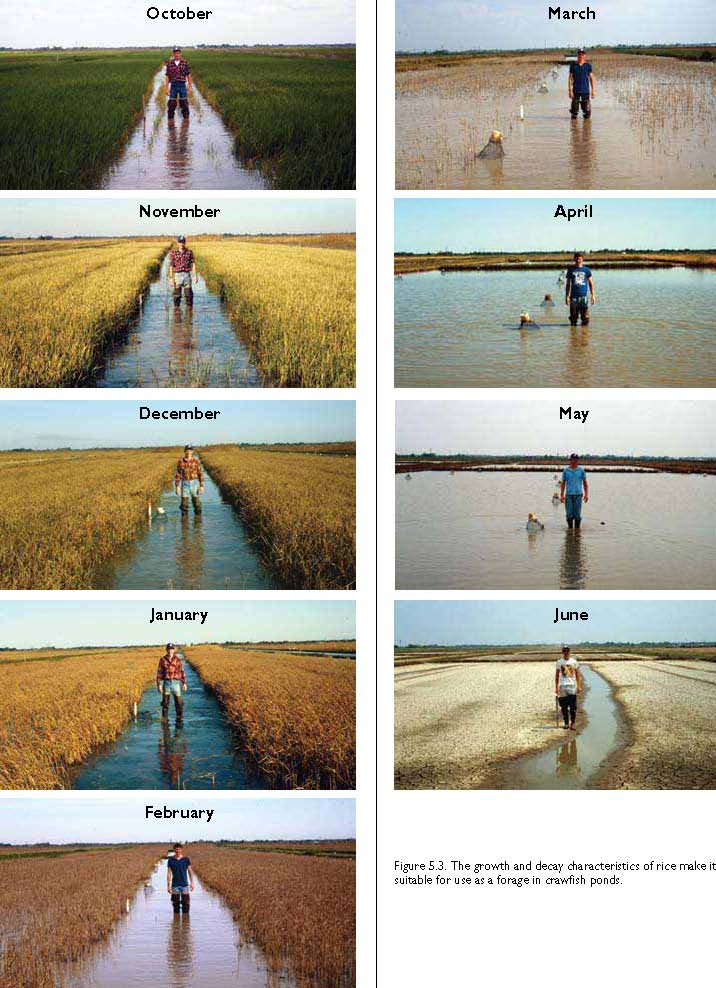
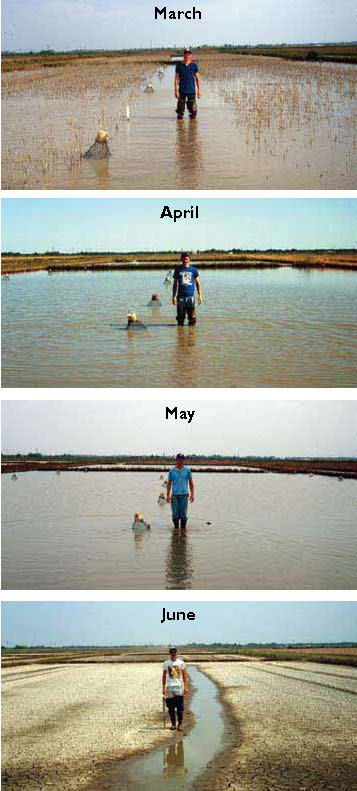
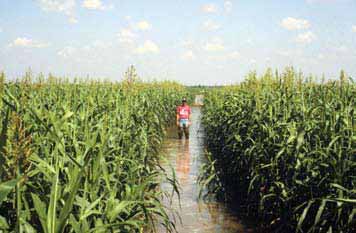
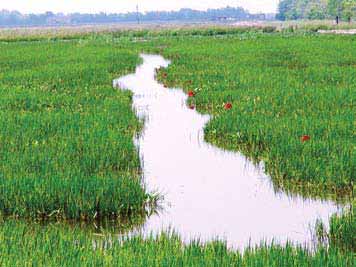
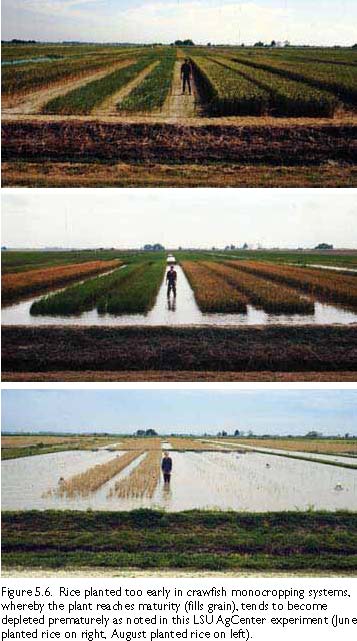
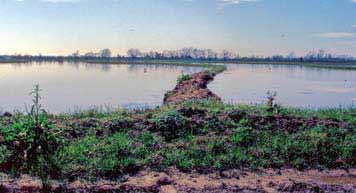
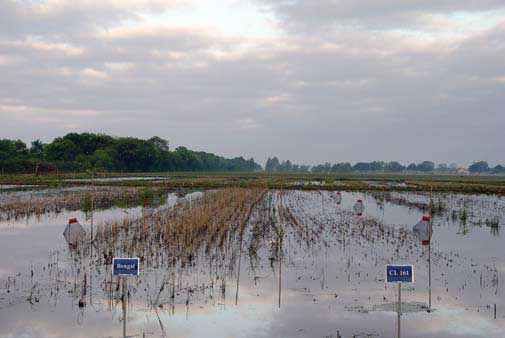

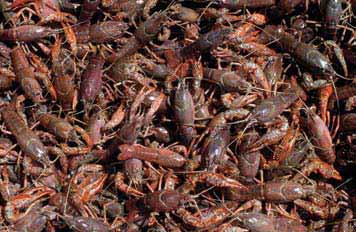
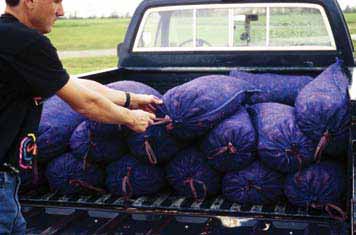
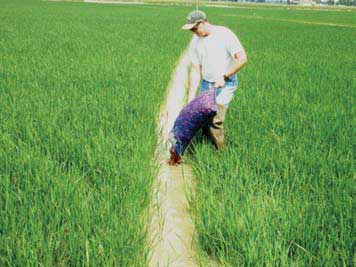

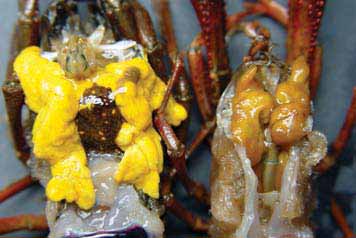
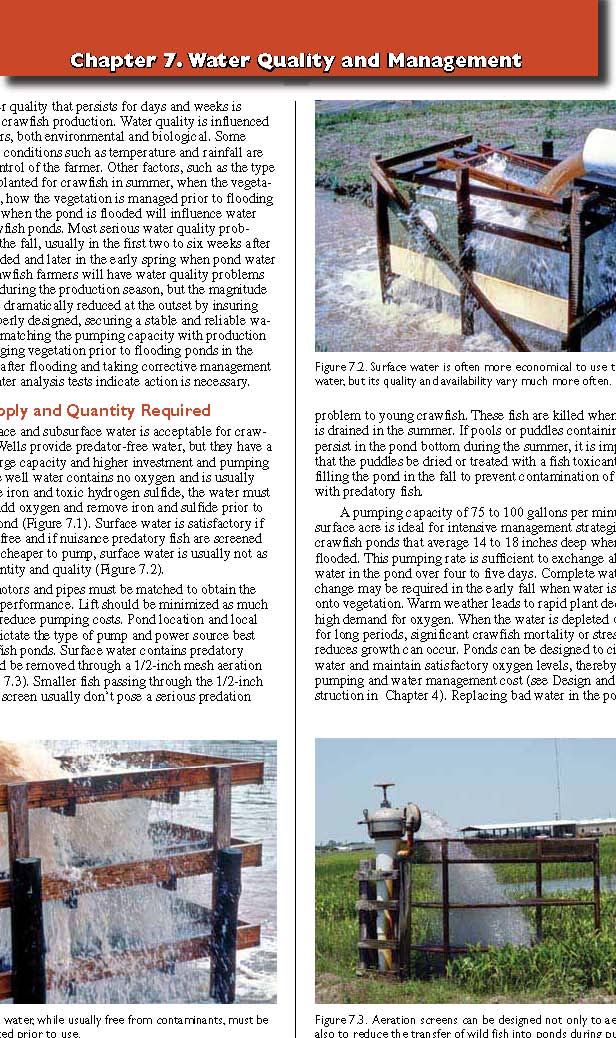

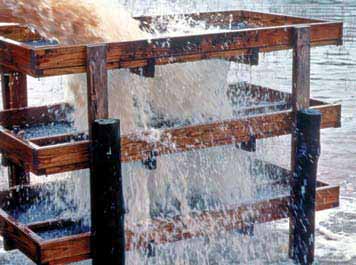

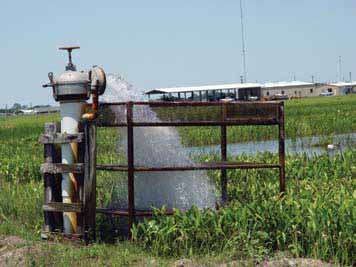
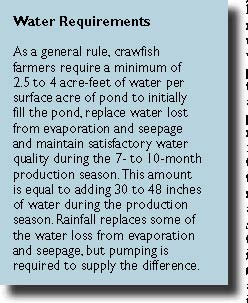 ponds. The following managewater supply is not acreage. By filling
flood-up, a pump acre will provide sufficient capacity ample, if the
pond it can be initially filled to 7 to 9 inches as opposed to 14 to
18 inches. Not only will there be less water to replace during low
oxygen episodes, but less vegetation is submerged and oxygen demand
is reduced. When temperatures have sufficiently cooled in winter,
usually below 65 F, and oxygen demand is reduced, additional water
can be added to bring the pond to full depth. One possible
disadvantage of the shallow flood is that females with young
burrowed near the top of the perimeter levee may not exit the burrow
if rainfall in the fall and winter is limited. If the water supply
is much less than 30 gallons per minute per surface acre, options
for effectively managing water for optimal crawfish production are
limited.
ponds. The following managewater supply is not acreage. By filling
flood-up, a pump acre will provide sufficient capacity ample, if the
pond it can be initially filled to 7 to 9 inches as opposed to 14 to
18 inches. Not only will there be less water to replace during low
oxygen episodes, but less vegetation is submerged and oxygen demand
is reduced. When temperatures have sufficiently cooled in winter,
usually below 65 F, and oxygen demand is reduced, additional water
can be added to bring the pond to full depth. One possible
disadvantage of the shallow flood is that females with young
burrowed near the top of the perimeter levee may not exit the burrow
if rainfall in the fall and winter is limited. If the water supply
is much less than 30 gallons per minute per surface acre, options
for effectively managing water for optimal crawfish production are
limited.
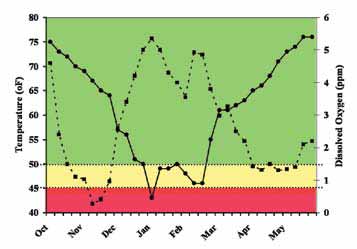
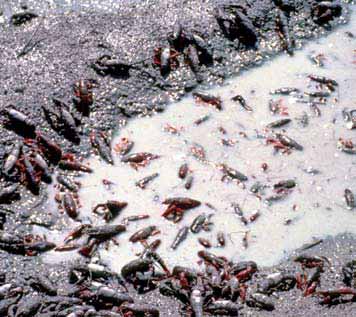
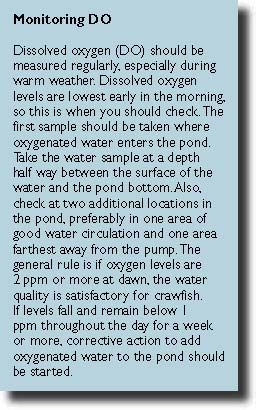
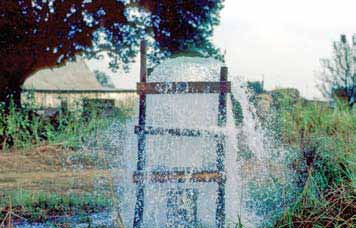
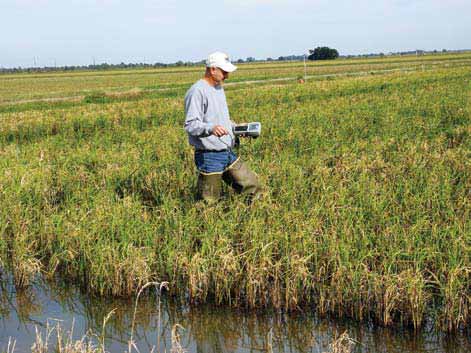 extension office for instructions on submitting
extension office for instructions on submitting
